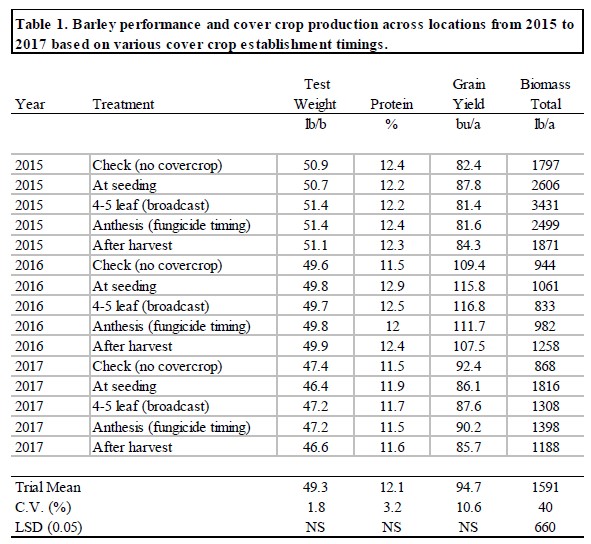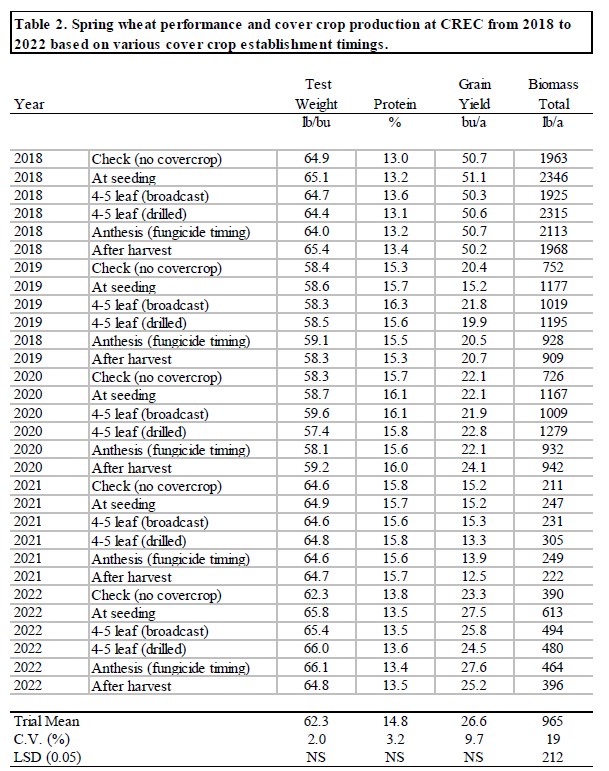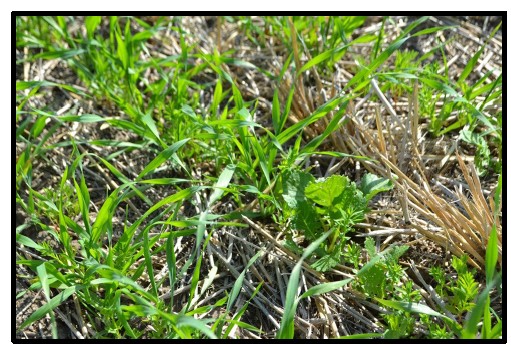Interest in planting cover crops has recently increased in North Dakota. The traditional method for seeding is to do so after a cereal grain crop. However, with our short growing season, the window to successfully establish a fall cover crop is limited. Most years, adequate moisture for germination is available for only 1 to 2 days after harvesting the small grain crop. If seeding later than this, germination of the cover crop is determined by the next adequate rainfall event, which may be days or weeks after harvest. Delayed germination drastically reduces the amount of biomass produced by the cover crop. Because labor is likely in short supply for most farms, combining and seeding at the same time can be challenging. This led us to ask the question: Where are the opportunities within the growing season to successfully establish a cover crop without impacting grain yield of the cash crop and not significantly increase production costs?
A small trial was conducted at the CREC as well as the Langdon, North Central (Minot), and Hettinger RECs, and at the Oakes Irrigation Site from 2015-2018 using barley as the cereal. The trial was continued at the CREC for an additional five years using HRSW as the cereal with the additional treatment of drilling at the 4-5 leaf stage.
The cover crop treatments were all one mixture of turnips, radishes, lentils, and flax planted into or after barley (2015-2017) or HRSW (2018-2022) as follows:
• Check (no cover crop seeded)
• At seeding with the drill (down the same seed tubes as the cereal)
• 4-5 leaf barley (herbicide application timing, broadcast applied)
• 4-5 leaf barley with the drill (only at the CREC)
• Anthesis (fungicide application timing)
• After harvest with a drill (traditional timing and method)
Table 1 shows the combined results from the three locations that were not severely impacted by drought and produced a harvestable grain crop: Carrington, Langdon, and North Central (Minot).
• In 2015, sufficient timely rains occurred after each cover crop seeding timing therefore all of the before harvest seeding timings produced significantly more biomass than the check and after harvest treatments.
• In 2016, there was an early dry spring with little significant rainfall after barley seeding. Despite that, a good barley crop was raised due to adequate subsoil moisture. However, the lack of rain impacted cover crop establishment and growth of all timings with none being significantly better than others.
• In 2017, again there was little significant rainfall after seeding, but there was adequate moisture close to the surface at the time of seeding to successfully establish the cover crop and then raise a respectable grain crop.
Table 2 shows the combined results from additional years at the CREC with HRSW as the cereal crop.
• The year 2018 started out dry in April, followed by below-average precipitation in May, above-average precipitation in June, and below normal, but timely, precipitation the remainder of the growing season. A good grain crop and biomass were produced on adequate subsoil moisture. The two drilled treatments produced significantly more biomass than the check and other treatments.
• 2019 also had below-average precipitation in April and May, which was followed by above-average precipitation in June and July. The three early-season treatments produced significantly more biomass than the check, anthesis, and harvest treatments.
• 2020 rainfall was well below average for the entire season with the exception of July. Again, two drilled treatments produced significantly more biomass than the check and other treatments.
• 2021 also had little significant rainfall after seeding. This lack of rain impacted grain yield and cover crop establishment with no treatments being significantly higher than others.
• In 2022, April and May had rainfall amounts that were well above average, followed by well below normal precipitation the remainder of the growing season. The ‘at seeding’ treatment produced significantly more biomass than the check and after harvest planting.
In summary, these practices should be utilized in relatively weed-free fields to be successful, as the herbicide program may be limited by most of these treatments. It is important to note that none of the treatments had a negative impact on the first-year cereal production. Also, none of these treatments had a statistically significant positive or negative impact on the following years HRSW crop. Research conducted on campus has shown that in conventionally-tilled soil the nitrogen benefits of these cover crops haven’t been seen in season or the following season. Ideally, this experiment would have been paired with no-till sites to determine if these treatments behave differently in no-till environments.
Cover crop mix seeded with the cereal crop.



